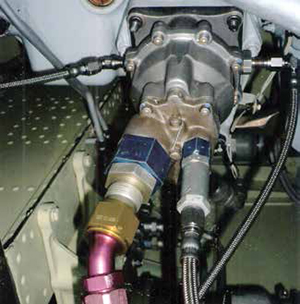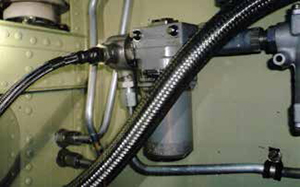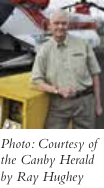
A Quick Guide to Troubleshooting Hydraulic System Internal Leaks


Here in my town, there is an automobile radiator repair shop with a motto of “A Good Place to Take a Leak.” It’s a catchy phrase and it might make some of us laugh; however, there is never a good time or place to have a hydraulic leak on a helicopter. External leaks are not so hard to find but internal leaks are another story. Should you suspect that your helicopter has an internal leak, read on for tips to help you locate the cause of the problem.
To Begin
The first step is to map the helicopter’s hydraulic system and components by measuring the hydraulic pressure temperature input and return on the hydraulic components, and write them down. This should be done when the system is running normally. This gives us a base line to use when we have to troubleshoot the system. We need to know what normal values are before we can determine if something is not right.

We can check the temperatures every month or when necessary. We can buy a laser temperature-measuring device at the local auto parts store. The dragster racers use them at the track. This device is great in checking the temperature of the surface of the dragster track to know what kind of tires to use. This measuring device is accurate enough to use on our hydraulic system components.
What Are the Signs?
Is the hydraulic system showing signs that all is not well? Is the fluid temperature hot and we can smell it? Is there discoloration of the fluid in the reservoir sight glass and paint blistering on any of the hydraulic components?

In the case of hydraulic pumps, check inlet suction temperature and then check pressure temperature. Looking at the picture of the hydraulic pump, the suction line going into the pump is bigger than the pressure out line. A normal hydraulic pump temperature should be at system temperature that is called out in the ICA for that model helicopter system. If the temperature shows an increase between pressure and return, this indicates the pump is leaking internally and is too hot to touch with your hands.
If we suspect that the irreversible valve attached to the actuator assembly is at fault, measure the temperature difference between the pressure and return lines. If one is higher than the other, check the other irreversible valves and compare the temperatures. This could pinpoint the problem unit.
In the picture of the filter assembly, measure the pressure coming from the hydraulic pump, through the filter assembly and out to the hydraulic system. The temperature between the inlet and outlet should be within about 15 degrees of each other. If we see a difference in the temperatures greater than 15 degrees, there is a strong possibility the filter element is starting to load up with contaminants.
Relief valves are also a culprit that can generate heat in hydraulic system component.
We obviously have not covered all possibilities concerning internal hydraulic leaks, but we have a path to quickly look at the systems major components.
If you have any problems with internal hydraulic leaks, please feel free to contact me at robertwpeterson69@yahoo.com.
 Robert Peterson entered the aviation field when he was drafted in 1963, despite being in college working towards a degree in mechanical engineering. He joined the U.S. Air Force and went to technical school on hydraulics and spent five years working on hydraulic systems on a virtual air show of aircraft. The F-4, F-105, F-106, F-102, B-52, KC-135, C-130, C-54, C-47, H-19 and the H-43, among others. If a new air aircraft came in, Peterson volunteered to work on it.
Robert Peterson entered the aviation field when he was drafted in 1963, despite being in college working towards a degree in mechanical engineering. He joined the U.S. Air Force and went to technical school on hydraulics and spent five years working on hydraulic systems on a virtual air show of aircraft. The F-4, F-105, F-106, F-102, B-52, KC-135, C-130, C-54, C-47, H-19 and the H-43, among others. If a new air aircraft came in, Peterson volunteered to work on it.
After leaving the military, Peterson went back to college to get his A&P certification and arrived at Columbia Helicopters in 1972. In 18 months, he became the hydraulic shop chief and held that position for more than 30 years. Peterson was a member of the Air National Guard for 31 years and is a member of the Standards of American Engineering (Aerospace Actuation, Control and Fluid Power Systems) A-6. He is currently under contract with Sunset Helicopters Inc. in Aurora, OR.
